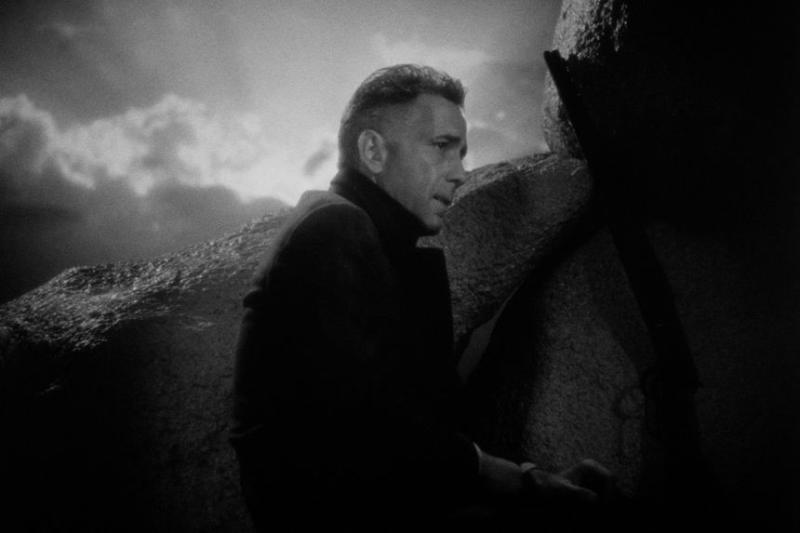The Pinnacle of ‘High Sierra’
By: By Kristin M. Jones



A notorious desperado, Roy Earle ( Humphrey Bogart ), is released from prison, and the first thing he wants to do is take a walk in a park. Asked if he is feeling all right, he says, “I will be, just as soon as I make sure that grass is still green and trees are still growing.” Bogart’s Earle breathes in the free air and becomes a character to remember.
The tale is “High Sierra” (1941), directed by Raoul Walsh, a gangster movie with a melancholy undertow that is one of many unforgettable films in various genres Walsh made during his long, prolific career. On Oct. 12, the Criterion Collection will release “High Sierra” on Blu-ray and DVD, with supplements illuminating the work of this often-underappreciated director.
Made for Warner Bros. and adapted from a novel by W.R. Burnett, who wrote the screenplay with John Huston, “High Sierra” has the fluid storytelling, visual beauty and emotional and physical momentum characteristic of Walsh’s work. Earle is set free only to hurtle into darkness and a harrowing showdown on a mountainside. As an accomplice, Doc Banton ( Henry Hull ), remarks: “Remember what Johnny Dillinger said about guys like you and him? He said you were just rushing toward death.”
Bogart was eager to be cast as Earle, after many less challenging parts. In Walsh’s electrifying “The Roaring Twenties” (1939), he played a gangster who is hard to the core. Earle is more complex—an Indiana farm boy turned bank robber who endured over eight years in prison and, set loose again, can’t help searching for what he lost along the way. Ida Lupino, who, alongside Bogart, had delivered a strong performance in Walsh’s darkly gripping trucking-world drama “They Drive by Night” (1940), also starred, receiving top billing.
After his release, the aging Earle drives west to carry out a jewel heist at a California resort hotel for an ailing friend who bought his pardon, Big Mac ( Donald MacBride ). He meets up at a mountain camp with two young, hotheaded gang members and a woman one of the men picked up in a Los Angeles dime-a-dance joint, Marie (Lupino).
Marie is a kindred spirit—smart, tough and vulnerable, with a similar urge to break out of unbearable situations. Earle lets her stay. The two become a makeshift family with a stray dog, Pard, although Earle wastes attention on Velma ( Joan Leslie ), a sheltered and ultimately ungrateful young woman he met along his journey. After the caper goes wrong, hope waxes and wanes as the story moves toward a breathtaking climax, shot brilliantly on location.
On the run, Earle is disgusted when he sees a newspaper that calls him “‘Mad Dog’ Earle,” a label that contrasts with his cool expertise, decency toward women and affection for Marie and Pard. But he sometimes seems animal-like in his urge to escape—in prison he saw a man commit suicide, while he always thought about “crashing out”—and he can attack with a tense ferocity.
In a small but unsettling comic role, Willie Best plays Algernon, a superstitious young handyman at the camp. The Criterion release includes an interview with the film and media historian Miriam J. Petty, who speaks about this talented Black actor’s career and the legacy of such limiting and stereotyped roles in Hollywood. Noting how this flattened character highlights the depth of Earle’s, she says: “He’s not there to show us things about Algernon. He’s there to reveal things about Roy Earle.”
In an excellent discussion between the critic Farran Smith
Nehme and Dave Kehr, a curator at the Museum of Modern Art, that is included with the release, Mr. Kehr says: “Everybody has their own idea of what the essence of cinema is. And I think, to me, it’s Raoul Walsh—it’s movement, it’s matching shots, it’s moving through space, it’s texture and light and sound.”
Walsh’s feeling for landscapes has special force in “High Sierra.” When Earle sees the grandeur of Mount Whitney, he can hardly stop looking. He also gazes with wonder at the stars glittering in the desert night sky, telling Velma that sometimes “you can almost feel the motion of the earth. It’s like a little ball that’s turning through the night with us hanging on to it.”
The supplements also include Walsh’s stellar remake of “High Sierra,” the noir western “Colorado Territory” (1949). Joel McCrea plays gunslinger Wes McQueen, busted out of jail to rob a train, while Virginia Mayo is Colorado, the woman he eventually realizes he loves. McQueen reacts to danger with preternatural physical grace, and the story takes on an uncanny quality as it unfolds in settings including a desolate, ruined town. When death comes, it’s as if one can see a world on the other side—like when a train stops but the earth seems to keep moving.
Romance can be as important as action in Walsh’s films, which include many richly imagined female characters. In both “High Sierra” and “Colorado Territory,” a weary outlaw learns that he won’t find peace through a shallow relationship or nostalgia for the past, but by moving into the unknown with someone fierce, intelligent and loyal. Earle’s love for Marie makes real freedom seem possible. When he ascends the mountain, he is rushing toward more than death.



I think director Raoul Walsh was a pioneer at a time when making movies was really in it's infancy. They kind of had to feel their way. He had a tremendous body of work, starting with silent films. In 1914 he worked on his first feature length film "The Life of General Villa " with the real Pancho Villa playing himself and with actual ongoing battles filmed in progress as well as recreations.

How's that for realism?
The high point of his career came at Warner Bros beginning in the late 30's with the movie The Roaring Twenties.
He served as an officer in the US Army in World War 1. He was a founding member of The Academy of Motion Picture Arts and Sciences.
He owned and bred Thoroughbred racehorses.
He made his last film in 1964 and died in 1980.
A good review. Thanks for posting it.